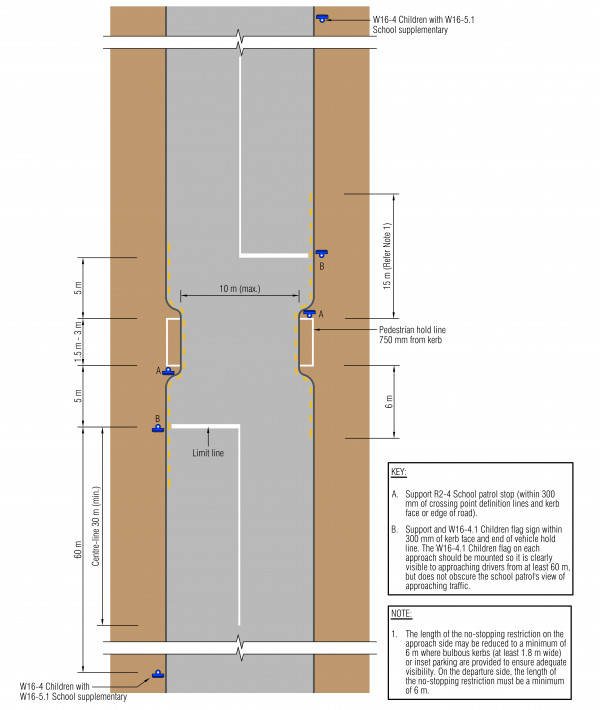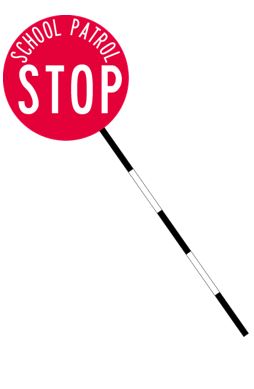A school patrol is used to assist, direct and supervise children on their way to or from school on an identified school crossing (kea crossing) point. The patrols are undertaken by approved members of the school community (adults and pupils). Further information and guidance on these facilities and board of trustees’ responsibilities can be found in clauses 8.3 and 8.4 of the TCD Rule and Traffic Note 29 and can also be found with the School traffic safety team manual.
A school crossing is a pedestrian crossing facility operated by members of a school patrol. The school patrol members may require traffic to stop to allow pedestrians to cross the road by extending School Patrol Signs into the roadway.
Where a school crossing operates, it must be operated in accordance with clause 8.3 of the TCD Rule.
The requirements for a school crossing point are outlined within clause 8.4 of the TCD Rule and include:
(1) A road controlling authority may provide a school crossing point on a road for which a speed limit of 50 km/h or less is set.
(2) A road controlling authority may provide a school crossing point on a road for which a speed limit of more than 50 km/h is set if it has obtained the approval of the Agency and complies with the conditions of the approval. (see note 1)
(3) Before establishing a school crossing point, a road controlling authority must obtain the agreement of the Board of Trustees of each school that is served by the school crossing point.
(4) A school crossing point must be placed so that:
(a) it, and the school patrol when operating, is visible to a driver approaching the crossing point from any direction; and
(b) the driver’s view of the entire length of the crossing is unobstructed by any permanent growth, construction or physical feature.
(7) Unless 8.4(8) applies, all ‘School Patrol’ signs and ‘Children’ flag signs must be removed from a school crossing point when a school patrol is not operating.
(8) ‘School Patrol’ signs and ‘Children’ flag signs may be stored at a school crossing point in storage devices that must:
(a) be designed to enclose the circular panel of a school patrol stop sign so that it is not readily visible when inside the storage device; and
(b) be white or grey in colour, with white or grey fittings, except that the surfaces of the storage device facing the footpath or the roadway may display a road safety message for pedestrians, providing that the message is not readily visible or distracting to vehicular traffic approaching the school crossing point; and
(c) unless the school patrol stop sign handle is white, shield the handle of the school patrol stop sign so that no black and white bands are visible when the school patrol sign is inside the storage device; and
(d) be oriented to present the smallest possible dimensions to vehicular traffic approaching the school crossing point.
Note 1: It is not good practice nor recommended that a school crossing point be installed on a road to which the posted speed limit is more than 50km/h. Waka Kotahi NZ Transport Agency must be consulted if there is intent to provide a pedestrian crossing in this instance.
The following signs and markings are used at school crossing points:
The RCA is responsible for installing and maintaining all signs and markings associated with the kea crossing.
A typical layout of a school crossing point is shown in Figure 7‑5, and guidance for the relevant signs is shown in Table 7‑2. Where a school crossing is installed across a road with cycle lanes or cycle paths, the cycle lane or cycle path may be continued through the crossing. However, the kerb buildouts required to achieve a maximum crossing distance of 10m will represent a pinch point for cyclists. Designers should take care to appropriately manage the conflict that may arise from this situation.
Figure 7‑5: Typical layout of a school crossing point.

View larger image [JPG, 3.3 MB]
Table 7‑2: Signs for school crossing points
| Sign code | Example | Description/use |
|---|---|---|
|
R2-4 RP31 (Pole) (see note 1) |
 |
Are to be used by properly trained and supervised personnel to control road traffic at sites where school patrols have been authorised to operate. The basic requirements for R2-4 & RP31 signs are set out in Schedule 1 and clause 8.3(7) of the TCD rule. The Rule requires a minimum size sign disc of 750mm diameter mounted at an angle on a pole or staff not less than 1.5m in length. The text and colouring may appear on both sides of the disc. For sign location see note 2. When the sign is not in use it must either be removed from the crossing point or stored in accordance with clause 8.4(8) of the TCD rule |
|
W16-4 Children W16-5.1 School - supplementary |
|
Should be installed where school buildings or grounds are adjacent to the road and where in the opinion of the RCA, passing traffic creates a hazard to pupils. Should not be used when a W16-2 and W16-5.1 sign combination is installed or where a W16-4 sign on its own would be more appropriate. An additional supplementary sign no larger than 600mm x 250mm, of the same colour and format as the W16-5.1 sign, and displaying the name of the school, may be installed on the same support and 100mm below the W16-4 and W16-5.1 sign combination. For sign location see note 3. |
|
W16-2 Pedestrian crossing W16-5.1 School - supplementary |
|
Should be installed in advance of a marked pedestrian crossing (zebra) at which a school patrol may be in attendance and on those crossings immediately adjacent to the school property which in the opinion of the RCA are used extensively by school children. For sign location see note 4. |
|
W16-4.1 Children flag sign |
 |
Children flag signs are removable, lightweight, collapsible, orange or red fluorescent, diamond shaped flags that are constructed of soft material. These signs are placed in special mounting posts that are situated on both kerb extensions so they are visible to motorists. They must only be used when a school crossing is in operation. When the signs are not in use they must either be removed from the crossing point or stored in accordance with clause 8.4(8) of the TCD rule. W16-4.1 Flags must not be used at pedestrian (zebra) crossings even if there is a school patrol operating (see note 5 below). For sign location see position ‘B’ in Figure 7‑5. |
Table 7-2 notes:
| Operating speed | Distance |
|---|---|
| 50km/h | 65m |
| 70km/h | 100m |
School crossing points (‘kea crossings’) on roads with speed limits exceeding 50km/h require the approval of Waka Kotahi. This is also applicable to existing school crossing points where the speed limit is increased.
The school and board of trustees are responsible for operating, training and supervising the crossing.
Further information is available in the school traffic safety team manual(external link)
Kea crossings are effective over a wide range of vehicle and pedestrian volumes. Kea crossings are impractical and unjustified where the half-hour product of pedestrians and vehicles is less than 3,000. While a number of sites have operated successfully where the half hour product exceeds 20,000, at these levels, alternative treatments should be considered.